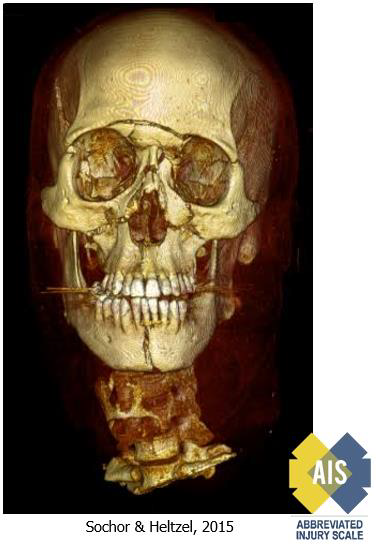The Abbreviated Injury Scale (AIS) is the international standard tool for documenting injury details and ranking injury severity. If an injury is not in the AIS dictionary, it cannot be coded. Unfortunately, this is becoming a real problem for many trauma registrars and researchers.
Here’s the issue: As their understanding of trauma improves, trauma data professionals increasingly run into injuries that do not fit in the AIS 2008 dictionary. Either the injury does not meet the AIS definition or there simply is no code for it in AIS 2008.
If your trauma program has experienced this problem, we encourage you to explore the new 2015 version of AIS. Adopting AIS 2015 at your trauma center will not only increase the accuracy of your data, it will solve lots of day-to-day coding problems.
Following are our “top five” problematic injuries that can now be coded accurately and efficiently with AIS 2015.
1. Coma that does not meet DAI criteria
In the head section of the AIS 2015 Dictionary there is now a code for cerebral concussion coma greater than 6 hours that does not meet diffuse axonal injury (DAI) criteria.
In the past, coma with prolonged loss of consciousness not due to mass lesion had to meet the AIS definition of DAI. The definition included immediate prolonged loss of consciousness greater than 6 hours, radiographic proof of shearing lesion and no other reason for loss of consciousness. The problem is that many seasoned coders have never found a patient who met these strict criteria.
Scenario: A patient was involved in a high-speed rollover motor vehicle crash. He suffered a head injury and never regained consciousness. The CT at 24 hours shows no mass lesion and there is no mention of shearing injury. The patient’s chart contains no other medical explanations for unconsciousness.
- AIS 2008: This type of coma is not codable
- AIS 2015: Use “cerebral concussion coma greater than 6 hours that does not meet diffuse axonal injury (DAI) criteria”
2. Ear injury that involves hearing loss
In the face section of AIS 2015 there is now a code for ear injury involving hearing loss.
The previous version of the AIS dictionary includes codes for dizziness and tinnitus but not hearing loss. In recent years, this has become a major gap. Blast injuries are notorious for causing hearing loss and are unfortunately becoming more prevalent.
Scenario: A patient was lighting a homemade pipe bomb on the Fourth of July. It exploded in his hands, injuring his left ear and perforating his tympanic membrane. The ENT progress note states the patient has permanent hearing loss in his left ear.
- AIS 2008: Hearing loss is not codable
- AIS 2015: Use “ear injury involving hearing loss”

3. Cord injury on scans but no neurologic deficits
In the spine section of the 2015 dictionary there is now a code for radiologic findings without transient or permanent impairment of cord. Previously, the only option was a “not further specified” (NFS) code that did not seem to address a “known” injury.
Scenario: A patient was involved in a motorcycle collision. She had an MRI of the C-spine 24 hours post-injury, which showed a cord contusion. The neurosurgeon’s progress note states the patient has no neurological deficits.
- AIS 2008: Use “Cord Contusion NFS”
- AIS 2015: Use “Cord Contusion, radiologic findings without transient or permanent impairment of cord”
4. Closed degloving injuries
In the extremity sections of the new dictionary there are now codes for closed degloving injuries — also known as a Morel-Lavallée lesions.
In the past we coded closed and open degloving injuries using the same codes. We can now differentiate the two, which will enable research on the outcomes associated with these sometimes very different injuries.
Scenario: In an industrial accident, a patient’s right upper extremity was caught in a conveyor belt. The trauma surgeon noted the patient sustained an internal degloving of the right upper extremity.
- AIS 2008: Use same code for all degloving injuries, whether closed or open
- AIS 2015: Use separate codes for closed degloving injuries and open degloving injuries
5. Heat injuries
In the external section of AIS 2015 there are now codes for heat injury.
In the past, registrars and researchers only had access to codes for hypothermia. The new codes allow us to capture injuries such as heat exhaustion, heat stroke and hyperpyrexia. These codes have many potential research applications — for example, studies of overheated military/civilian personnel or children/disabled people left or trapped in hot vehicles.
Scenario: A patient arrives at the trauma center after falling off the back of a trash truck. The city was under a heat warning, and on initial assessment the patient’s temperature was 107 degrees F / 42 degrees C.
- AIS 2008: Heat injury is not codable
- AIS 2015: Use one of several codes for hyperthermia
New features for superior coding
These are just a few examples of the updates in AIS 2015 that will improve trauma data capture and research. In addition, the AIS 2015 Dictionary features:
Updated terminology. Updates to medical diagnoses and terminology offer the precision that medical specialists require for injury severity and outcomes descriptions.

New illustrations. AIS 2015 includes updated anatomical illustrations and clinical images to enhance the coder’s experience. In addition, 3D CT reconstructions are included in course materials (see examples above and at right). The goal is to facilitate superior injury coding through improved understanding of the involved anatomical structures.
Compatibility with other scoring systems. The new dictionary is compatible with other existing or proposed injury scoring systems, such as the Duma Eye Score (DES) and the American Spinal Injury Association (ASIA) Impairment Scale.
New codes for combat injuries. AIS 2015 includes several new codes that will aid the military in coding combat injuries. Some codes cover less serious injuries, such as peppering injuries of the skin. Others describe more serious injuries that are generally only seen during warfare — for example, massive soft tissue destruction of an extremity or empty cranial vault.
New codes support research and injury prevention
Trauma professionals such as registrars, abstractors and researchers are paid to be detail-oriented, so leaving injuries without a code is very frustrating. Uncoded injuries also underestimate injury severity, which makes trauma data less useful.
The revisions and updates in AIS 2015 were thoughtfully planned and designed to cover the injuries we are seeing today. We are all looking forward to the research initiatives and injury prevention activities that will be made possible by this enhanced code set.
Amy Brammer, BSN, RN, TNS, CEN, CAISS, CSTR
Trauma Program Director, Kaiser Permanente Vacaville Medical Center
Chair of the Abbreviated Injury Scale Certification Board
Faculty for the Abbreviated Injury Scale Course
Kathryn Loftis, PhD, CAISS
Biomedical Engineering Researcher
Faculty Trainer for the Association for the Advancement of Automotive Medicine
Sara B. Heltzel, MS, CST, CAISS, CTBS
Anatomical Donations Coordinator, UVA Center for Applied Biomechanics
Faculty for the Abbreviated Injury Scale Course
References
Association for the Advancement of Automotive Medicine. Abbreviated Injury Scale 2015 Dictionary. Chicago: Association for Advancement of Automotive Medicine. 2015.
Roberts TT, Leonard GR, Cepela DJ. Classifications In Brief: American Spinal Injury Association (ASIA) Impairment Scale. Clin Orthop Relat Res. 2016.
Scott WR, Lloyd WC, Benedict JV, Meredith R. Ocular injuries due to projectile impacts. Annu Proc Assoc Adv Automot Med. 2000;44:205-17.

